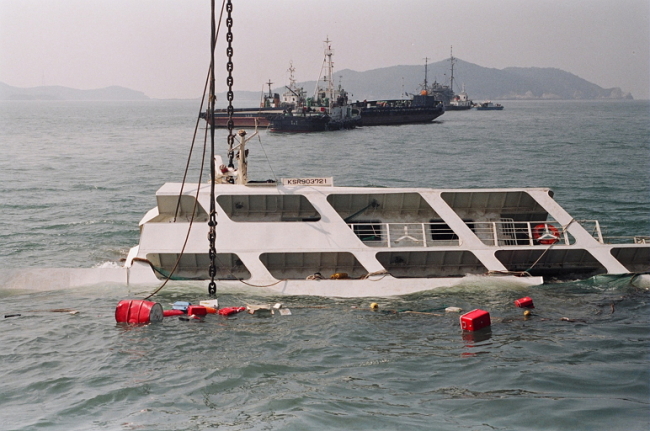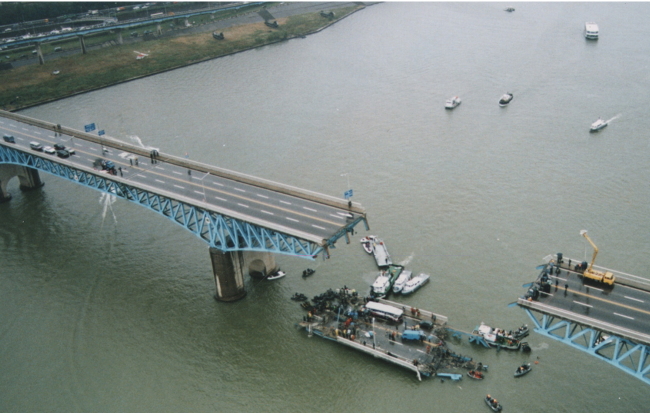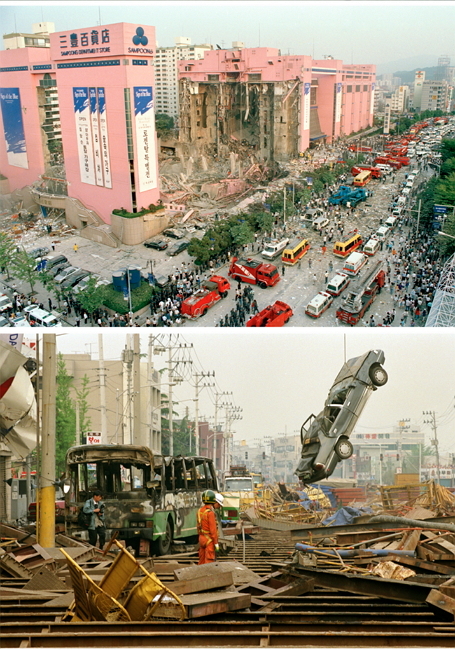This is the first in a series of articles that examine Korean’s preparedness for disasters and social risks in light of the recent Sewol tragedy. ― Ed.
The ferry left despite foggy conditions, the ship was overloaded with cargo that was not properly tied down, the amount of ballast water in the ferry was far below what would have been necessary for the vessel to keep stable, the ship’s crew were among the first to flee without assisting the passengers, and the Coast Guard apparently did not follow its own procedures for rescue operations.
The Sewol ferry disaster, which claimed more than 300 lives on April 16, was a man-made disaster that snowballed in magnitude as the shipping company, the ship’s crew and the authorities blatantly disregarded laws and regulations.
 |
The Sewol ferry sinking on April 16 |
 |
The Seohae ferry sinking in 1993 |
In fact, failure to stick to the rules has been a major contributing factor in most of Korea’s man-made disasters. The Seohae Ferry disaster in 1993, which claimed 292 lives, the 1994 Seongsu Bridge collapse, which took 32 lives, the Sampoong Department Store collapse, which killed 502 people in 1995, the Daegu gas explosion in 1995 that claimed 101 lives and the 1999 Sea Land fire which resulted in the deaths of 23 people, including 19 kindergarteners, are but some of the accidents that could have been foreseen and prevented had the relevant rules and regulations been observed.
As Koreans ask why the country ― the 13th-largest economy in the world ― remains vulnerable to man-made disasters, some point to the process of rapid industrialization of the ’60s to the ’80s that saw Korea rise from the rubble of the Korean War to become the thriving economy it is today.
The culture of “ppalli ppalli,” or “hurry hurry,” is a byproduct of the era which saw economic development as the overarching goal. The whole country was in overdrive, disregarding rules and procedures if necessary, as it pursued accelerated economic development. Following decades of such circumvention of laws, Korean society became desensitized to the risks it was taking.
 |
The Seongsu Bridge collapse in 1994 |
 |
(from top)The Sampoong Department Store collapse in 1995The Daegu subway gas explosion in 1995 |
Park Gil-sung, a sociology professor at Korea University, notes a number of unique cultural cognition factors that may be at play that elevate risk: Unfounded optimism which leads to thinking that everything will go well, adventurism that views acute reaction to danger as cowardly behavior, and exceptionalism or thinking “I will be alright.”
“Together, baseless optimism and adventurism heighten the explosiveness of potential risks,” Park observed. “Add self-exceptionalism to the combination and this leads to insensitivity to risks,” Park said.
Fatalism, or the view that man has no power to influence the future or his own action, may explain why Koreans do not act proactively in anticipation of future danger or a crisis situation. In a 1996 book on abnormal psychology, Kwon Seok-man, professor of psychology at Seoul National University, writes about the passive fatalistic view that permeates through Korean culture. Fortunetelling and feng shui enjoy widespread popularity here because of the pervasiveness of fatalism, he noted.
As for Korea’s Confucian tradition and its emphasis on obeying the authorities that is often cited in the West as a root of Korean society’s many ills, including accidents and disasters, Korea University’s Park offers a different interpretation.
Positing that while problems such as the Sewol ferry disaster may indeed have emerged because of the authoritarianism that prevails in society, Park said authoritarianism in the negative sense ― i.e. Confucian, imperial, patriarchal authorities ― that have been pervasive in Korean society for a long time is now no more.
“Korea seems to have succeeded in overthrowing the ‘old authoritarianism’ in the process of democratization and during the 1997 Asian financial crisis,” he said.
However, the country has not been able to find new authority, the most important element of social order, which can determine right and wrong.
“The biggest concern now is that we have not been able to produce a new form of authority,” Park said. “There is an authority vacuum, an anomie,” he said.
“The Sewol disaster is an example of the result of this new situation,” he pointed out.
“We need to ponder about the authority that is necessary to create order in Korean society. This is not something that is created through a system. There must be an accompanying culture,” Park said.
By Kim Hoo-ran, Senior Writer (
khooran@heraldcorp.com)










![[From the Scene] At this Starbucks, you need ID: Franchise opens store with view of North Korea](http://res.heraldm.com/phpwas/restmb_idxmake.php?idx=644&simg=/content/image/2024/11/29/20241129050068_0.jpg)
